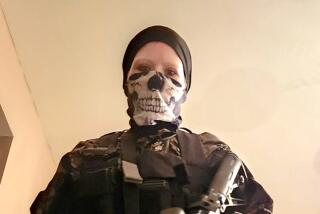Official discloses new details of Al Qaeda plot
ASPEN, Colo. -- A sophisticated Al Qaeda bomb built to take down passenger planes was designed to avoid detection by trained dogs and bomb detection machines at airport security checkpoints, according to John Pistole, chief of the Transportation Security Administration.
The CIA and other intelligence agencies obtained the device after they penetrated an Al Qaeda cell in Yemen and disrupted a plot that was reportedly timed to the first anniversary of Osama bin Laden’s death.
Pistole said Ibrahim Hassan Asiri, a Saudi-born bomb maker, has trained other Al Qaeda operatives in Yemen. He remains at large.
The implication was that killing Asiri, a priority for counter terrorism officials, may not eliminate the threat he poses to aviation. It was the first time a U.S. official has publicly disclosed that assessment.
Pistole described Asiri as “our greatest threat. All the intel folks here know that is a clear and present danger.”
U.S. officials believe Asiri designed the underwear bomb worn by Umar Farouk Abdulmutallab, who tried to blow up a Northwest Airlines passenger plane over Detroit in December 2009. The bomb malfunctioned and Abdulmutallab was arrested.
Asiri is also thought to be behind a bomb his brother inserted in a body cavity in an attempt to assassinate the Saudi deputy minister of Interior, Muhammad bin Nayef, in August 2009. The blast killed the bomber, but not his target.
The new bomb was obtained after an intelligence operation involving an informant who infiltrated Al Qaeda in Yemen and convinced the group that he would use the device to blow up an American airplane in 2011.
The Associated Press later learned details of the operation, a leak that is now the subject of a criminal investigation that led the Justice Department to seize AP phone records.
Speaking at the annual Aspen Security Forum, Pistole said the plot involved “a next generation device” that was “new and improved in many respects” from earlier bombs. He said it featured “a new type of explosive that we had never seen.”
He said it utilized “a double initiation system,” two different syringes to mix liquid explosives. It also was covered in caulk to shield its scent from machines and dogs, he said.
“All of our explosive detection equipment wasn’t calibrated to detect that,” Pistole said. “And all of our 800 bomb-sniffing dogs had not been trained for that specific type.”
Follow Politics Now on Twitter and Facebook
Twitter: @kendilanianLAT
More to Read
Sign up for Essential California
The most important California stories and recommendations in your inbox every morning.
You may occasionally receive promotional content from the Los Angeles Times.











